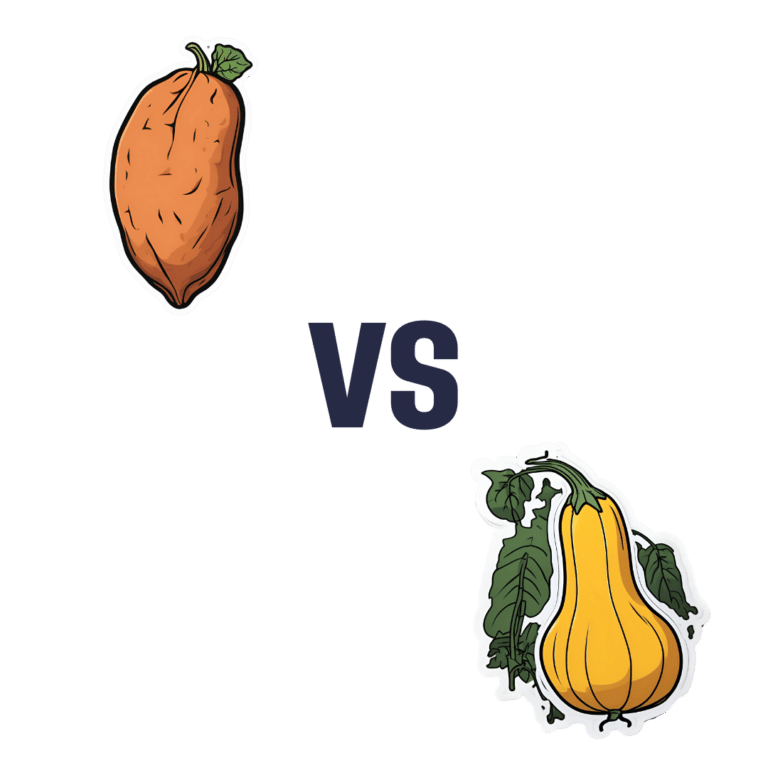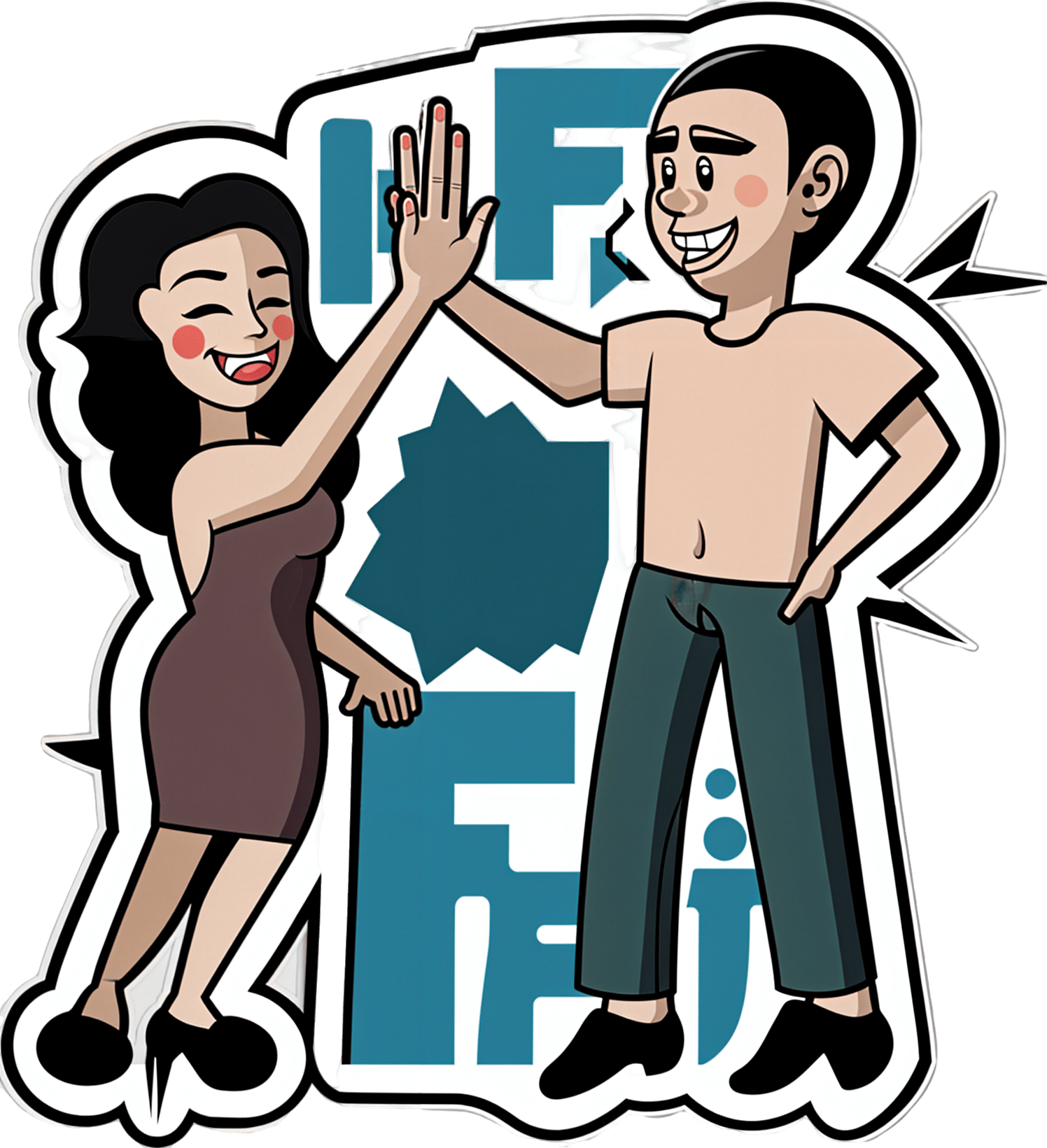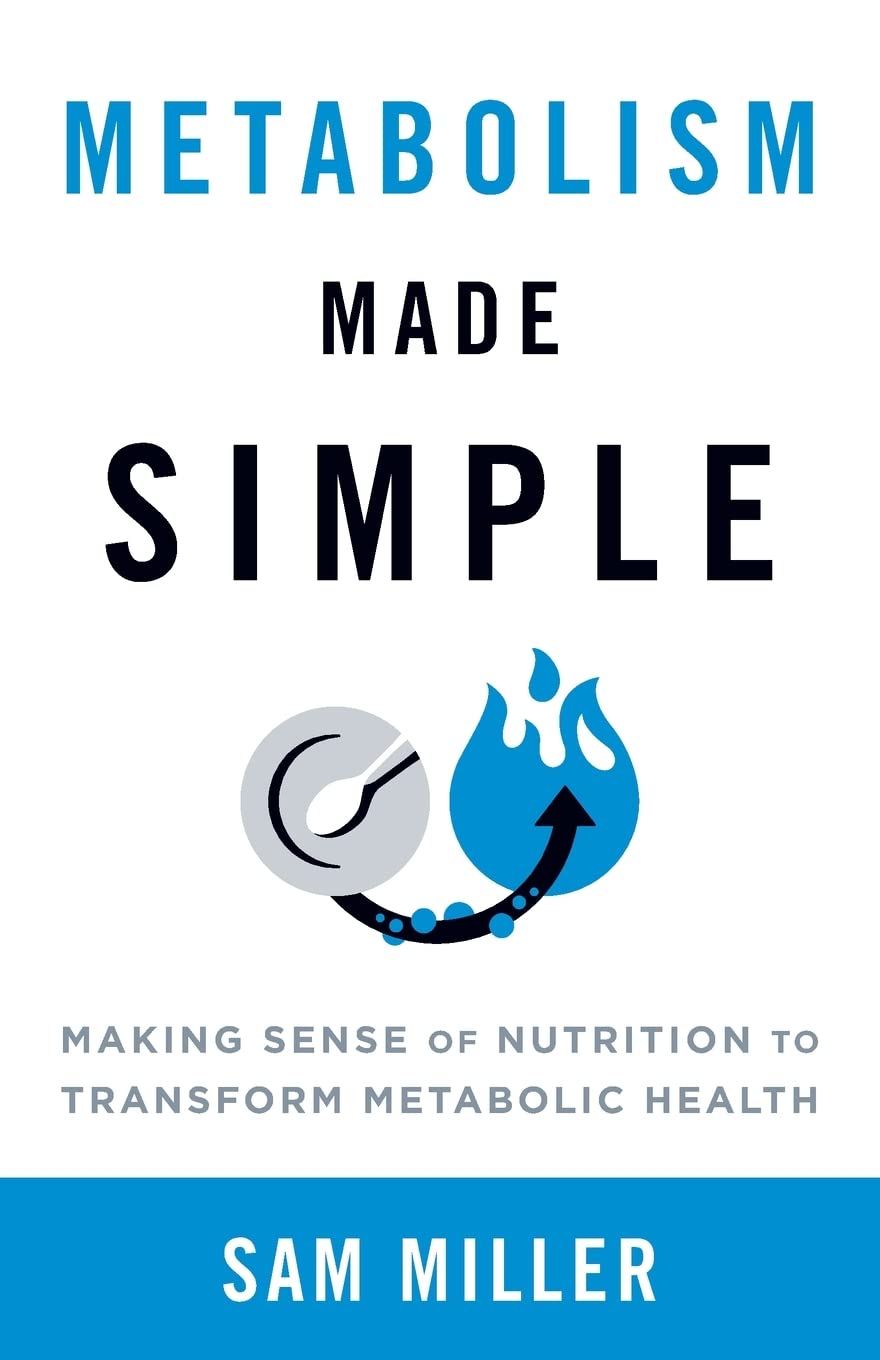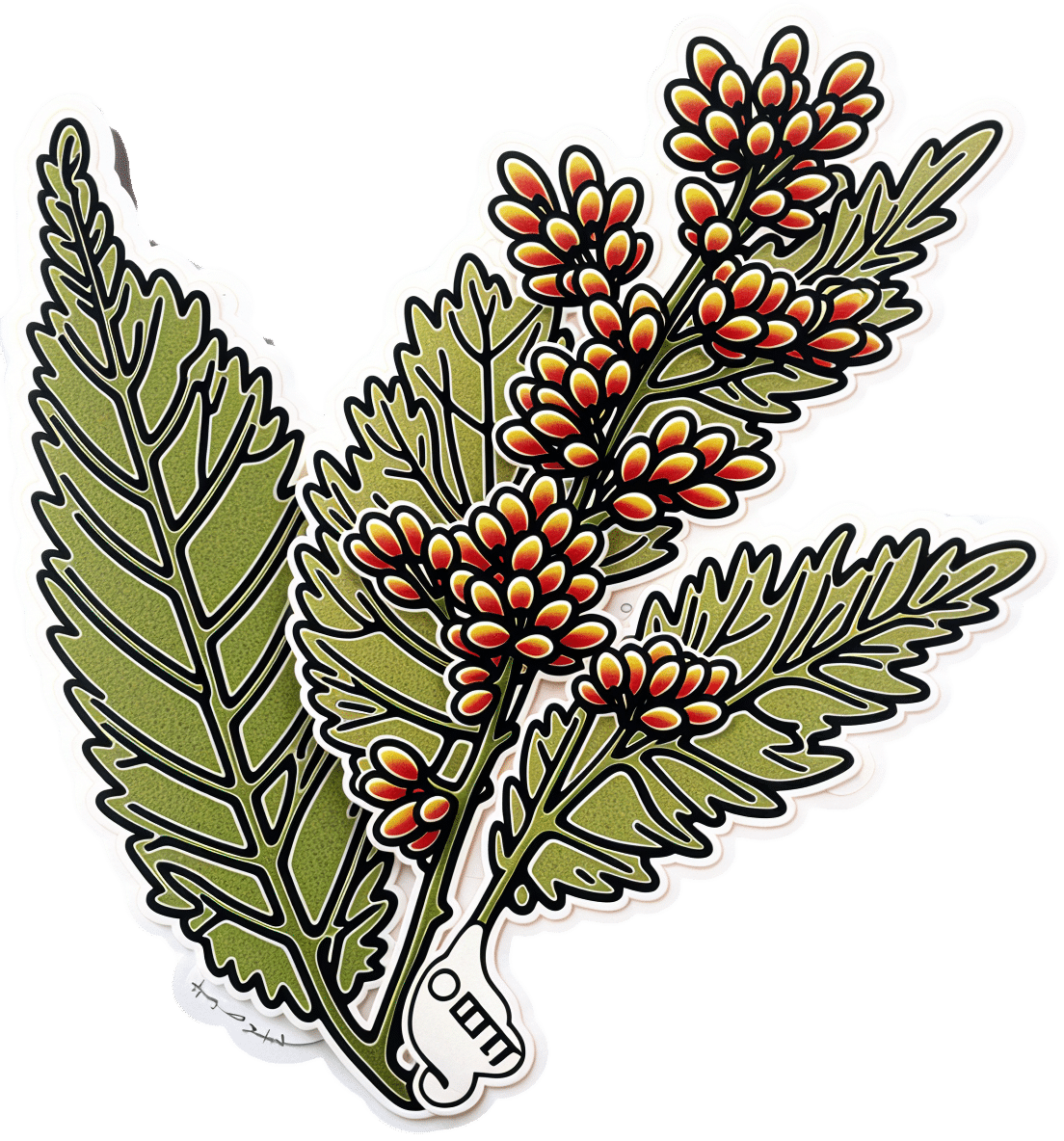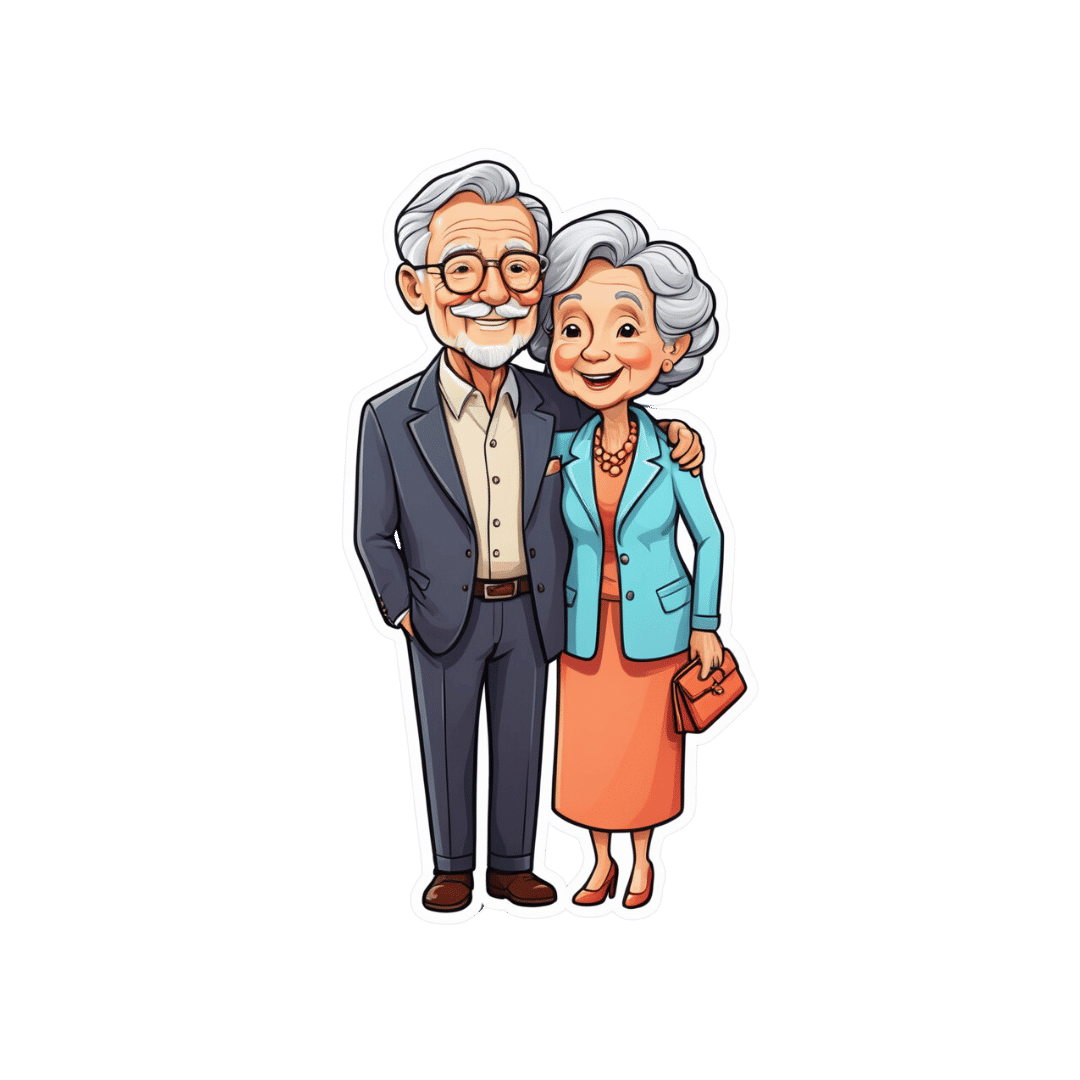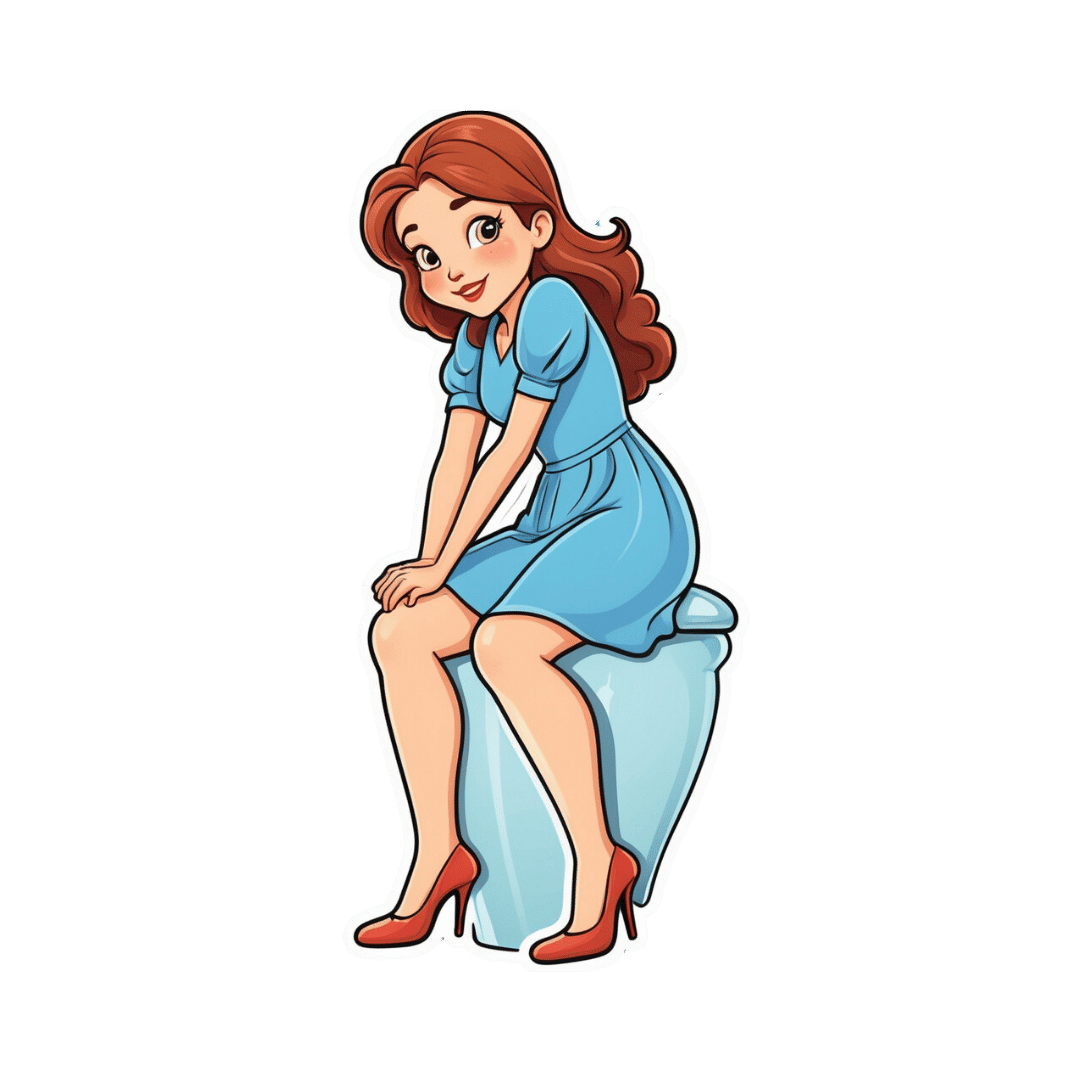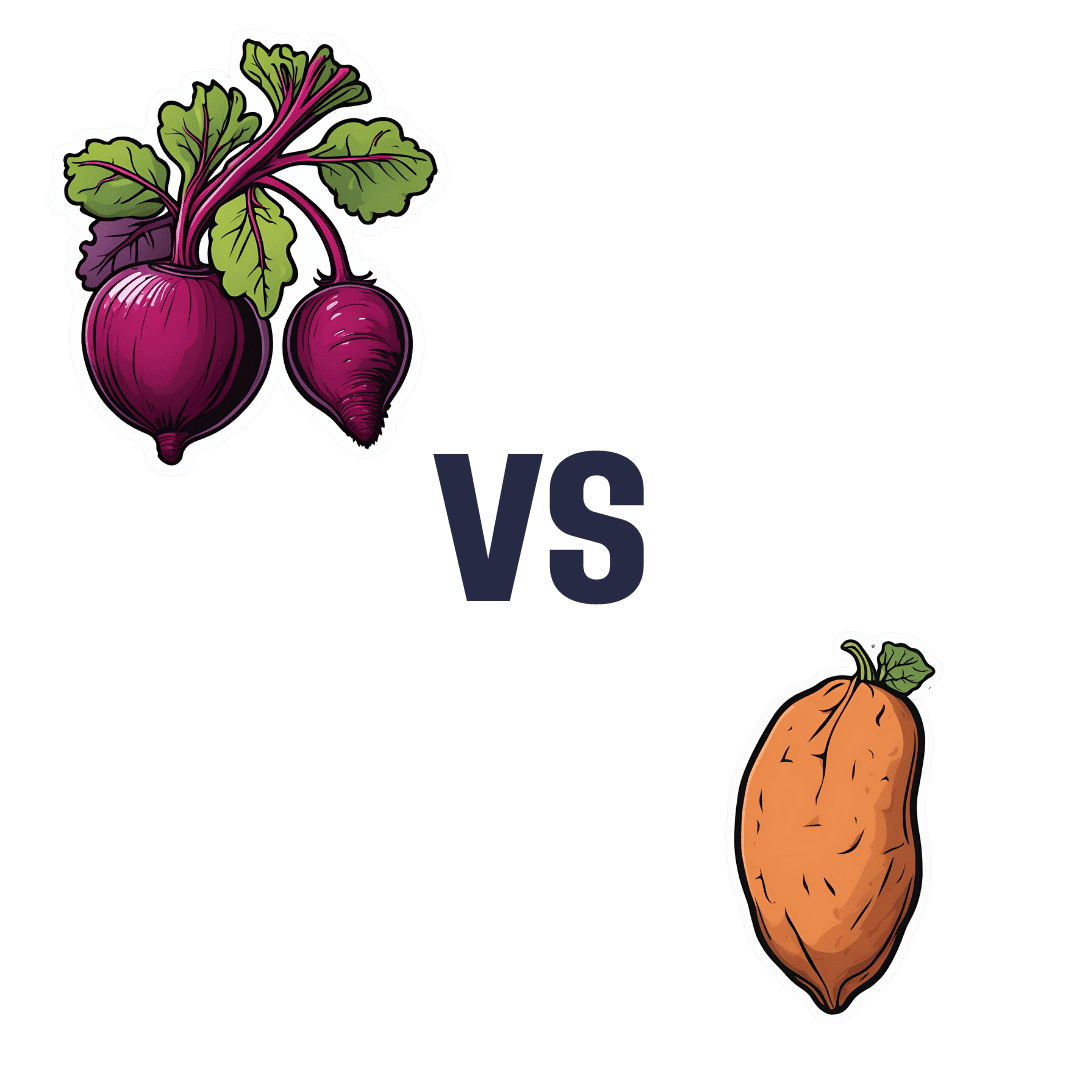
Beetroot vs Sweet Potato – Which is Healthier?
10almonds is reader-supported. We may, at no cost to you, receive a portion of sales if you purchase a product through a link in this article.
Our Verdict
When comparing beetroot to sweet potato, we picked the sweet potato.
Why?
Quite a straightforward one today!
In terms of macros, sweet potato has more protein, carbs, and fiber. The glycemic index of both of these root vegetables is similar (and in each case varies similarly depending on how it is cooked), so we’ll call the winner the one that’s more nutritionally dense—the sweet potato.
Looking at vitamins next, beetroot has more vitamin B9 (and is in fact a very good source of that, unlike sweet potato), and/but sweet potato is a lot higher in vitamins A, B1, B2, B3, B5, B6, B7, C, E, K, and choline. And we’re talking for example more than 582x more vitamin A, more than 17x more vitamin E, more than a 10x more vitamin K, and at least multiples more of the other vitamins mentioned. So this category’s not a difficult one to call for sweet potato.
When it comes to minerals, beetroot has more selenium, while sweet potato has more calcium, copper, magnesium, manganese, phosphorus, and potassium. They’re approximately equal in iron and zinc. Another win for sweet potato.
Of course, enjoy both. But if you’re looking for the root vegetable that’ll bring the most nutrients, it’s the sweet potato.
Want to learn more?
You might like to read:
No, beetroot isn’t vegetable Viagra. But here’s what else it can do
Take care!
Don’t Forget…
Did you arrive here from our newsletter? Don’t forget to return to the email to continue learning!
Recommended
Learn to Age Gracefully
Join the 98k+ American women taking control of their health & aging with our 100% free (and fun!) daily emails:
-
Why is cancer called cancer? We need to go back to Greco-Roman times for the answer
10almonds is reader-supported. We may, at no cost to you, receive a portion of sales if you purchase a product through a link in this article.
One of the earliest descriptions of someone with cancer comes from the fourth century BC. Satyrus, tyrant of the city of Heracleia on the Black Sea, developed a cancer between his groin and scrotum. As the cancer spread, Satyrus had ever greater pains. He was unable to sleep and had convulsions.
Advanced cancers in that part of the body were regarded as inoperable, and there were no drugs strong enough to alleviate the agony. So doctors could do nothing. Eventually, the cancer took Satyrus’ life at the age of 65.
Cancer was already well known in this period. A text written in the late fifth or early fourth century BC, called Diseases of Women, described how breast cancer develops:
hard growths form […] out of them hidden cancers develop […] pains shoot up from the patients’ breasts to their throats, and around their shoulder blades […] such patients become thin through their whole body […] breathing decreases, the sense of smell is lost […]
Other medical works of this period describe different sorts of cancers. A woman from the Greek city of Abdera died from a cancer of the chest; a man with throat cancer survived after his doctor burned away the tumour.
Where does the word ‘cancer’ come from?
Why does the word ‘cancer’ have its roots in the ancient Greek and Latin words for crab? The physician Galen offers one explanation. Pierre Roche Vigneron/Wikimedia The word cancer comes from the same era. In the late fifth and early fourth century BC, doctors were using the word karkinos – the ancient Greek word for crab – to describe malignant tumours. Later, when Latin-speaking doctors described the same disease, they used the Latin word for crab: cancer. So, the name stuck.
Even in ancient times, people wondered why doctors named the disease after an animal. One explanation was the crab is an aggressive animal, just as cancer can be an aggressive disease; another explanation was the crab can grip one part of a person’s body with its claws and be difficult to remove, just as cancer can be difficult to remove once it has developed. Others thought it was because of the appearance of the tumour.
The physician Galen (129-216 AD) described breast cancer in his work A Method of Medicine to Glaucon, and compared the form of the tumour to the form of a crab:
We have often seen in the breasts a tumour exactly like a crab. Just as that animal has feet on either side of its body, so too in this disease the veins of the unnatural swelling are stretched out on either side, creating a form similar to a crab.
Not everyone agreed what caused cancer
The physician Erasistratus didn’t think black bile was to blame. Didier Descouens/Musée Ingres-Bourdelle/Wikimedia, CC BY-SA In the Greco-Roman period, there were different opinions about the cause of cancer.
According to a widespread ancient medical theory, the body has four humours: blood, yellow bile, phlegm and black bile. These four humours need to be kept in a state of balance, otherwise a person becomes sick. If a person suffered from an excess of black bile, it was thought this would eventually lead to cancer.
The physician Erasistratus, who lived from around 315 to 240 BC, disagreed. However, so far as we know, he did not offer an alternative explanation.
How was cancer treated?
Cancer was treated in a range of different ways. It was thought that cancers in their early stages could be cured using medications.
These included drugs derived from plants (such as cucumber, narcissus bulb, castor bean, bitter vetch, cabbage); animals (such as the ash of a crab); and metals (such as arsenic).
Galen claimed that by using this sort of medication, and repeatedly purging his patients with emetics or enemas, he was sometimes successful at making emerging cancers disappear. He said the same treatment sometimes prevented more advanced cancers from continuing to grow. However, he also said surgery is necessary if these medications do not work.
Surgery was usually avoided as patients tended to die from blood loss. The most successful operations were on cancers of the tip of the breast. Leonidas, a physician who lived in the second and third century AD, described his method, which involved cauterising (burning):
I usually operate in cases where the tumours do not extend into the chest […] When the patient has been placed on her back, I incise the healthy area of the breast above the tumour and then cauterize the incision until scabs form and the bleeding is stanched. Then I incise again, marking out the area as I cut deeply into the breast, and again I cauterize. I do this [incising and cauterizing] quite often […] This way the bleeding is not dangerous. After the excision is complete I again cauterize the entire area until it is dessicated.
Cancer was generally regarded as an incurable disease, and so it was feared. Some people with cancer, such as the poet Silius Italicus (26-102 AD), died by suicide to end the torment.
Patients would also pray to the gods for hope of a cure. An example of this is Innocentia, an aristocratic lady who lived in Carthage (in modern-day Tunisia) in the fifth century AD. She told her doctor divine intervention had cured her breast cancer, though her doctor did not believe her.
Innocentia from Carthage, in modern-day Tunisia, believed divine intervention cured her breast cancer. Valery Bareta/Shutterstock From the past into the future
We began with Satyrus, a tyrant in the fourth century BC. In the 2,400 years or so since then, much has changed in our knowledge of what causes cancer, how to prevent it and how to treat it. We also know there are more than 200 different types of cancer. Some people’s cancers are so successfully managed, they go on to live long lives.
But there is still no general “cure for cancer”, a disease that about one in five people develop in their lifetime. In 2022 alone, there were about 20 million new cancer cases and 9.7 million cancer deaths globally. We clearly have a long way to go.
Konstantine Panegyres, McKenzie Postdoctoral Fellow, Historical and Philosophical Studies, The University of Melbourne
This article is republished from The Conversation under a Creative Commons license. Read the original article.
Share This Post
-
Too Much Or Too Little Testosterone?
10almonds is reader-supported. We may, at no cost to you, receive a portion of sales if you purchase a product through a link in this article.
One Man’s Saw Palmetto Is Another Woman’s Serenoa Repens…
Today we’re going to look at saw palmetto. So, first:
What is it?
Saw palmetto is a type of palm native to the southeastern United States. Its scientific name is “Serenoa repens”, so if that name appears in studies we cite, it’s the same thing. By whichever name, it’s widely enjoyed as a herbal supplement.
Why do people take it?
Here’s where it gets interesting, because people take it for some completely opposite reasons…
Indeed, searching for it on the Internet will cause Google to suggest “…for men” and “…for women” as the top suggestions.
That’s because it works on testosterone, and testosterone can be a bit of a double-edged sword, so some people want to increase or decrease certain testosterone-related effects on their body.
And it works for both! Here be science:
- Testosterone (henceforth, “T”) is produced in the human body.
- Yes, all human bodies, to some extent.
- An enzyme called 5-alpha-reductase converts T in to DHT (dihydrogen testosterone)
- DHT is a much more potent androgen (masculinizing agent) than T alone, such that its effects are often unwanted, including:
- Enlarged prostate (if you have one)
- Hair loss (especially in men)
- New facial hair growth (usually unwanted by women)
- Women are more likely to get this due to PCOS and/or the menopause
To avoid those effects, you really want less of your T to be converted into DHT.
Saw palmetto is a 5α-reductase inhibitor, so if you take it, you’ll have less DHT, and you’ll consequently lose less hair, have fewer prostate problems, etc.
^The above study showed that saw palmetto extract performed comparably to finasteride. Finasteride is the world’s main go-to prescription drug for treating enlarged prostate and/or hair loss.
See also: Natural Hair Supplement: Friend or Foe? Saw Palmetto, a Systematic Review in Alopecia
Hair today… Growing tomorrow!
So, what was that about increasing T levels?
Men usually suffer declining T levels as they get older, with a marked drop around the age of 45. With lower T comes lower energy, lower mood, lower libido, erectile dysfunction, etc.
Guess what… It’s T that’s needed for those things, not DHT. So if you block the conversion of T to DHT, you’ll have higher blood serum T levels, higher energy, higher mood, higher libido, and all that.
(the above assumes you have testicles, without which, your T levels will certainly not increase)
Saw Palmetto Against Enlarged Prostate?
With higher DHT levels in mid-late life, prostate enlargement (benign prostatic hyperlasia) can become a problem for many men. The size of that problem ranges from urinary inconvenience (common, when the prostate presses against the bladder) to prostate cancer (less common, much more serious). Saw palmetto, like other 5α-reductase inhibitors such as finasteride, may be used to prevent or treat this.
Wondering how safe/reliable it is? We found a very high-quality fifteen-year longitudinal observational study of the use of saw palmetto, and it found:
❝The 15 years’ study results suggest that taking S. repens plant extract continuously at a daily dose of 320 mg is an effective and safe way to prevent the progression of benign prostatic hyperplasia.❞
Want a second opinion? We also found a 10-year study (by different researchers with different people taking it), which reached the same conclusion:
❝The results of study showed the absence of progression, both on subjective criteria (IPSS, and QoL scores), and objective criteria (prostate volume, the rate of urination, residual urine volume). Furthermore, patients had no undesirable effects directly related to the use of this drug.❞
- IPSS = International Prostate Symptom Score
- QoL = Quality of Life
❝But wait a minute; I, a man over the age of 45 with potentially declining T levels but a fabulous beard, remember that you said just a minute ago that saw palmetto is used by women to avoid having facial hair; I don’t want to lose mine!❞
You won’t. Once your facial hair follicles were fully developed and activated during puberty, they’ll carry on doing what they do for life. That’s no longer regulated by hormones once they’re up and running.
The use of saw palmetto can only be used to limit facial hair if caught early—so it’s more useful at the onset of menopause, for those who have (or will have) such, or else upon the arrival of PCOS symptoms or hirsuitism from some other cause.
Take The Test!
Do you have a prostate, and would like to know your IPSS score, and what that means for your prostate health?
(takes 1 minute, no need to pee or go probing for anything)
Bottom Line on Saw Palmetto
- It blocks the conversion of T into DHT
- It will increase blood serum T levels, thus boosting mood, energy, libido, etc in men (who typically have more T, but whose T levels decline with age)
- It will decrease DHT levels, thus limiting hair loss (especially in men) and later-life new facial hair growth (especially in women).
- It can be used to prevent or treat prostate enlargement
- Bonus: it’s a potent antioxidant and thus reduces general inflammation (in everyone)
Want To Try Saw Palmetto?
We don’t sell it (or anything else), but for your convenience…
Share This Post
- Testosterone (henceforth, “T”) is produced in the human body.
-
Metabolism Made Simple – by Sam Miller
10almonds is reader-supported. We may, at no cost to you, receive a portion of sales if you purchase a product through a link in this article.
The author, a nutritionist, sets out to present exactly what the title promises: metabolism made simple.
On this, he delivers. Explaining things from the most basic elements upwards, he gives a well-rounded introduction to the science of metabolism and what it means for us when it comes to our dietary habits.
The book is in large part a how-to, but with a lot of flexibility left to the reader. He doesn’t advocate for any particular dietary plan, but he does give the reader the tools necessary to make an informed choice and go from there—including the pros and cons of some popular dietary approaches.
He talks a lot about getting the most out of whatever we do choose to—managing appetite, mitigating adaptation, maximizing adherence, optimizing absorption of nutrients, and so forth.
The book does also touch on things like exercise and stress management, but diet is always center-stage and is the main topic of the book.
The style is—as promised by the title—simple. However, this simply means that he avoids unnecessary jargon and explains any necessary terms along the way. As for backing up claims with science, there are 22 pages of references, which is always a good sign.
Bottom line: if you’d like a simple, practical guide to eating for metabolic health, this book will start you off on a good footing.
Click here to check out Metabolism Made Simple, and give your metabolic health a boost!
Share This Post
Related Posts
-
Fisetin: The Anti-Aging Assassin
10almonds is reader-supported. We may, at no cost to you, receive a portion of sales if you purchase a product through a link in this article.
Out With The Old…
Fisetin is a flavonoid (specifically, a flavonol), but it’s a little different than most. While it has the usual antioxidant, anti-inflammatory, and anti-cancer properties you might reasonably expect from flavonoids, it has an extra anti-aging trick up its sleeve that most don’t.
❝Fisetin is a flavonol that shares distinct antioxidant properties with a plethora of other plant polyphenols. Additionally, it exhibits a specific biological activity of considerable interest as regards the protection of functional macromolecules against stress which results in the sustenance of normal cells cytoprotection. Moreover, it shows potential as an anti-inflammatory, chemopreventive, chemotherapeutic and recently also senotherapeutic agent❞
~ Dr. Grynkiewicz & Dr. Demchuk
Let’s briefly do some due diligence on its expected properties, and then we’ll take a look at its bonus anti-aging effects.
The flavonol that does-it-ol
Because of the similar mechanisms involved, there are three things that often come together, which are:
- Antioxidant
- Anti-inflammatory
- Anticancer
This list often gets expanded to also include:
- Anti-aging
…although that is usually the last thing to get tested out of that list.
In today’s case, let’s kick it off with…
❝Fisetin (3,3′,4′,7-tetrahydroxyflavone) is a dietary flavonoid found in various fruits (strawberries, apples, mangoes, persimmons, kiwis, and grapes), vegetables (tomatoes, onions, and cucumbers), nuts, and wine that has shown strong anti-inflammatory, anti-oxidant, anti-tumorigenic, anti-invasive, anti-angiogenic, anti-diabetic, neuroprotective, and cardioprotective effects❞
Read more: Fisetin and Its Role in Chronic Diseases
Understanding its anticancer mechanisms
The way that fisetin fights cancer is basically “all the ways”, and this will be important when we get to its special abilities shortly:
❝Being a potent anticancer agent, fisetin has been used to inhibit stages in the cancer cells (proliferation, invasion),prevent cell cycle progression, inhibit cell growth, induce apoptosis, cause polymerase (PARP) cleavage, and modulate the expressions of Bcl‐2 family proteins in different cancer cell lines (HT‐29, U266, MDA‐MB‐231, BT549, and PC‐3M‐luc‐6), respectively. Further, fisetin also suppresses the activation of the PKCα/ROS/ERK1/2 and p38 MAPK signaling pathways, reduces the NF‐κB activation, and down‐regulates the level of the oncoprotein securin. Fisetin also inhibited cell division and proliferation and invasion as well as lowered the TET1 expression levels. ❞
Read more: Fisetin: An anticancer perspective
There’s also more about it than we even have room to quote, here:
Now For What’s New And Exciting: Senolysis
All that selectivity that fisetin exhibits when it comes to “this cell gets to live, and this one doesn’t” actions?
It makes a difference when it comes to aging, too. Because aging and cancer happen by quite similar mechanisms; they’re both DNA-copying errors that get copied forward, to our detriment.
- In the case of cancer, it’s a cell line that accidentally became immortal and so we end up with too many of them multiplying in one place (a tumor)
- In the case of aging, it’s the cellular equivalent of “a photocopy of a photocopy of a photocopy” gradually losing information as it goes
In both cases…
The cell must die if we want to live
Critically, and which quality differentiates it from a lot of other flavonoids, fisetin has the ability to selectively kill senescent cells.
To labor the photocopying metaphor, this means there’s an office worker whose job it is to say “this photocopy is barely legible, I’m going to toss this, and then copy directly from the clearest copy we have instead”, thus keeping the documents (your DNA) in pristine condition.
In fisetin’s case, this was first tested in mouse (in vivo) studies, and in human tissue (in vitro) studies, before moving to human clinical studies:
❝Of the 10 flavonoids tested, fisetin was the most potent senolytic.
The natural product fisetin has senotherapeutic activity in mice and in human tissues. Late life intervention was sufficient to yield a potent health benefit.❞
~ Dr. Matthew Yousefzadeh et al.
Read in full: Fisetin is a senotherapeutic that extends health and lifespan
There’s lots more science that’s been done to it since that first groundbreaking study though; here’s a more recent example:
Want some?
We don’t sell it, but here for your convenience is an example product on Amazon
Enjoy!
Don’t Forget…
Did you arrive here from our newsletter? Don’t forget to return to the email to continue learning!
Learn to Age Gracefully
Join the 98k+ American women taking control of their health & aging with our 100% free (and fun!) daily emails:
-
STI rates are increasing among midlife and older adults. We need to talk about it
10almonds is reader-supported. We may, at no cost to you, receive a portion of sales if you purchase a product through a link in this article.
Globally, the rates of common sexually transmissible infections (STIs) are increasing among people aged over 50. In some cases, rates are rising faster than among younger people.
Recent data from the United States Centers for Disease Control and Prevention shows that, among people aged 55 and older, rates of gonorrhoea and chlamydia, two of the most common STIs, more than doubled between 2012 and 2022.
Australian STI surveillance data has reflected similar trends. Between 2013 and 2022, there was a steady increase in diagnoses of chlamydia, gonorrhoea and syphilis among people aged 40 and older. For example, there were 5,883 notifications of chlamydia in Australians 40 plus in 2013, compared with 10,263 in 2022.
A 2020 study of Australian women also showed that, between 2000 and 2018, there was a sharper increase in STI diagnoses among women aged 55–74 than among younger women.
While the overall rate of common STIs is highest among young adults, the significant increase in STI diagnoses among midlife and older adults suggests we need to pay more attention to sexual health across the life course.
Fit Ztudio/Shutterstock Why are STI rates rising among older adults?
STI rates are increasing globally for all age groups, and an increase among midlife and older people is in line with this trend.
However, increases of STIs among older people are likely due to a combination of changing sex and relationship practices and hidden sexual health needs among this group.
The “boomer” generation came of age in the 60s and 70s. They are the generation of free love and their attitude to sex, even as they age, is quite different to that of generations before them.
Given the median age of divorce in Australia is now over 43, and the internet has ushered in new opportunities for post-separation dating, it’s not surprising that midlife and older adults are exploring new sexual practices or finding multiple sexual partners.
People may start new relationships later in life. Tint Media/Shutterstock It’s also possible midlife and older people have not had exposure to sexual health education in school or do not relate to current safe sex messages, which tend to be directed toward young people. Condoms may therefore seem unnecessary for people who aren’t trying to avoid pregnancy. Older people may also lack confidence negotiating safe sex or accessing STI screening.
Hidden sexual health needs
In contemporary life, the sex lives of older adults are largely invisible. Ageing and older bodies are often associated with loss of power and desirability, reflected in the stereotype of older people as asexual and in derogatory jokes about older people having sex.
With some exceptions, we see few positive representations of older sexual bodies in film or television.
Older people’s sexuality is also largely invisible in public policy. In a review of Australian policy relating to sexual and reproductive health, researchers found midlife and older adults were rarely mentioned.
Sexual health policy generally targets groups with the highest STI rates, which excludes most older people. As midlife and older adults are beyond childbearing years, they also do not feature in reproductive health policy. This means there is a general absence of any policy related to sex or sexual health among midlife or older adults.
Added to this, sexual health policy tends to be focused on risk rather than sexual wellbeing. Sexual wellbeing, including freedom and capacity to pursue pleasurable sexual experiences, is strongly associated with overall health and quality of life for adults of all ages. Including sexual wellbeing as a policy priority would enable a focus on safe and respectful sex and relationships across the adult life course.
Without this priority, we have limited knowledge about what supports sexual wellbeing as people age and limited funding for initiatives to engage with midlife or older adults on these issues.
Midlife and older adults may have limited knowledge about STIs. Southworks/Shutterstock How can we support sexual health and wellbeing for older adults?
Most STIs are easily treatable. Serious complications can occur, however, when STIs are undiagnosed and untreated over a long period. Untreated STIs can also be passed on to others.
Late diagnosis is not uncommon as some STIs can have no symptoms and many people don’t routinely screen for STIs. Older, heterosexual adults are, in general, less likely than other groups to seek regular STI screening.
For midlife or older adults, STIs may also be diagnosed late because some doctors do not initiate testing due to concerns they will cause offence or because they assume STI risk among older people is negligible.
Many doctors are reluctant to discuss sexual health with their older patients unless the patient explicitly raises the topic. However, older people can be embarrassed or feel awkward raising matters of sex.
Resources for health-care providers and patients to facilitate conversations about sexual health and STI screening with older patients would be a good first step.
To address rising rates of STIs among midlife and older adults, we also need to ensure sexual health promotion is targeted toward these age groups and improve accessibility of clinical services.
More broadly, it’s important to consider ways to ensure sexual wellbeing is prioritised in policy and practice related to midlife and older adulthood.
A comprehensive approach to older people’s sexual health, that explicitly places value on the significance of sex and intimacy in people’s lives, will enhance our ability to more effectively respond to sexual health and STI prevention across the life course.
Jennifer Power, Associate Professor and Principal Research Fellow, Australian Research Centre in Sex, Health and Society, La Trobe University
This article is republished from The Conversation under a Creative Commons license. Read the original article.
Don’t Forget…
Did you arrive here from our newsletter? Don’t forget to return to the email to continue learning!
Learn to Age Gracefully
Join the 98k+ American women taking control of their health & aging with our 100% free (and fun!) daily emails:
-
New study suggests weight loss drugs like Ozempic could help with knee pain. Here’s why there may be a link
10almonds is reader-supported. We may, at no cost to you, receive a portion of sales if you purchase a product through a link in this article.
The drug semaglutide, commonly known by the brand names Ozempic or Wegovy, was originally developed to help people with type 2 diabetes manage their blood sugar levels.
However, researchers have discovered it may help with other health issues, too. Clinical trials show semaglutide can be effective for weight loss, and hundreds of thousands of people around the world are using it for this purpose.
Evidence has also shown the drug can help manage heart failure and chronic kidney disease in people with obesity and type 2 diabetes.
Now, a study published in the New England Journal of Medicine has suggested semaglutide can improve knee pain in people with obesity and osteoarthritis. So what did this study find, and how could semaglutide and osteoarthritis pain be linked?
Pormezz/Shutterstock Osteoarthritis and obesity
Osteoarthritis is a common joint disease, affecting 2.1 million Australians. Most people with osteoarthritis have pain and find it difficult to perform common daily activities such as walking. The knee is the joint most commonly affected by osteoarthritis.
Being overweight or obese is a major risk factor for osteoarthritis in the knee. The link between the two conditions is complex. It involves a combination of increased load on the knee, metabolic factors such as high cholesterol and high blood sugar, and inflammation.
For example, elevated blood sugar levels increase the production of inflammatory molecules in the body, which can damage the cartilage in the knee, and lead to the development of osteoarthritis.
Weight loss is strongly recommended to reduce the pain of knee osteoarthritis in people who are overweight or obese. International and Australian guidelines suggest losing as little as 5% of body weight can help.
But losing weight with just diet and exercise can be difficult for many people. One study from the United Kingdom found the annual probability of people with obesity losing 5% or more of their body weight was less than one in ten.
Semaglutide has recently entered the market as a potential alternative route to weight loss. It comes from a class of drugs known as GLP-1 receptor agonists and works by increasing a person’s sense of fullness.
Semaglutide for osteoarthritis?
The rationale for the recent study was that while we know weight loss alleviates symptoms of knee osteoarthritis, the effect of GLP-1 receptor agonists was yet to be explored. So the researchers set out to understand what effect semaglutide might have on knee osteoarthritis pain, alongside body weight.
They randomly allocated 407 people with obesity and moderate osteoarthritis into one of two groups. One group received semaglutide once a week, while the other group received a placebo. Both groups were treated for 68 weeks and received counselling on diet and physical activity. At the end of the treatment phase, researchers measured changes in knee pain, function, and body weight.
As expected, those taking semaglutide lost more weight than those in the placebo group. People on semaglutide lost around 13% of their body weight on average, while those taking the placebo lost around 3% on average. More than 70% of people in the semaglutide group lost at least 10% of their body weight compared to just over 9% of people in the placebo group.
Osteoarthritis of the knee is the most common type of osteoarthritis. SKT Studio/Shutterstock The study found semaglutide reduced knee pain significantly more than the placebo. Participants who took semaglutide reported an additional 14-point reduction in pain on a 0–100 scale compared to the placebo group.
This is much greater than the pain reduction in another recent study among people with obesity and knee osteoarthritis. This study investigated the effects of a diet and exercise program compared to an attention control (where participants are provided with information about nutrition and physical activity). The results here saw only a 3-point difference between the intervention group and the control group on the same scale.
The amount of pain relief reported in the semaglutide trial is also larger than that reported with commonly used pain medicines such as anti-inflammatories, opioids and antidepressants.
Semaglutide also improved knee function compared to the placebo. For example, people who took semaglutide could walk about 42 meters further than those on the placebo in a six-minute walking test.
How could semaglutide reduce knee pain?
It’s not fully clear how semaglutide helps with knee pain from osteoarthritis. One explanation may be that when a person loses weight, there’s less stress on the joints, which reduces pain.
But recent studies have also suggested semaglutide and other GLP-1 receptor agonists might have anti-inflammatory properties, and could even protect against cartilage wear and tear.
While the results of this new study are promising, it’s too soon to regard semaglutide as a “miracle drug” for knee osteoarthritis. And as this study was funded by the drug company that makes semaglutide, it will be important to have independent studies in the future, to confirm the findings, or not.
The study also had strict criteria, excluding some groups, such as those taking opioids for knee pain. One in seven Australians seeing a GP for their knee osteoarthritis are prescribed opioids. Most participants in the trial were white (61%) and women (82%). This means the study may not fully represent the average person with knee osteoarthritis and obesity.
It’s also important to consider semaglutide can have a range of side effects, including gastrointestinal symptoms and fatigue.
There are some concerns that semaglutide could reduce muscle mass and bone density, though we’re still learning more about this.
Further, it can be difficult to access.
I have knee osteoarthritis, what should I do?
Osteoarthritis is a disease caused by multiple factors, and it’s important to take a multifaceted approach to managing it. Weight loss is an important component for those who are overweight or obese, but so are other aspects of self-management. This might include physical activity, pacing strategies, and other positive lifestyle changes such as improving sleep, healthy eating, and so on.
Giovanni E. Ferreira, NHMRC Emerging Leader Research Fellow, Institute of Musculoskeletal Health, University of Sydney and Christina Abdel Shaheed, Associate Professor, School of Public Health, University of Sydney
This article is republished from The Conversation under a Creative Commons license. Read the original article.
Don’t Forget…
Did you arrive here from our newsletter? Don’t forget to return to the email to continue learning!
Learn to Age Gracefully
Join the 98k+ American women taking control of their health & aging with our 100% free (and fun!) daily emails:

